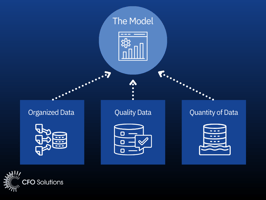Welcome to the final chapter of our insightful series on machine learning for financial...
Unleashing the Power of Machine Learning
The history and application of machine learning (ML) within mathematical forecasting is a fascinating subject that has been gaining increasing interest in recent years. As machine learning continues to develop, its impact on various industries is becoming more evident. What exactly is machine learning, and how has it evolved over the years?
Machine Learning in its infancy
Arthur Samuel, a pioneer in the field of artificial intelligence, developed a computer program that could learn to play checkers at a high level. Samuel realized that the program wasn't just following pre-programmed rules but was learning from its own experiences and improving over time. And thus, the term "machine learning" was born.
But machine learning didn't truly stop there. It has since been heavily influenced by statistical methods, particularly time series regression and correlation analysis which can take us back to 1899 by the work of Yule and Reginald Hooker, in the field of Econometrics.
These statistical techniques are used to analyze data over time, like stock prices or weather patterns, and identify patterns and trends that can be used to make predictions about future behavior. And when combined with machine learning algorithms, like neural networks and decision trees, the accuracy of these predictions can be improved even further.
The Importance of Machine Learning-1.png?width=491&height=276&name=Linkedin%2c%20Twitter%2c%20Facebook%20(1)-1.png)
It's no wonder that this combination of machine learning and time series regression analysis has become so important in the field of mathematical forecasting. Businesses and governments around the world rely on these forecasts to make informed decisions and plan for the future.
One of the significant milestones in the history of machine learning was the development of support vector machines and the introduction of the backpropagation algorithm for neural networks in the 1980s and 1990s. These innovations revolutionized the field of machine learning by allowing for the processing of larger and more complex datasets, making it an increasingly valuable tool in various industries.
Support vector machines (SVMs) are a type of machine learning algorithm that is used for classification and regression analysis. SVMs were developed by Vapnik and Chervonenkis in the 1960s, but it wasn't until the 1990s that they gained popularity. These were used in a wide range of applications, including image classification, text classification, and bioinformatics.
The backpropagation algorithm, on the other hand, is a method for training artificial neural networks. It was first introduced by Rumelhart, Hinton, and Williams in the 1980s and quickly became a standard algorithm for training neural networks. The backpropagation algorithm allows neural networks to learn and adapt to new data by adjusting the weights of the connections between neurons. This enables neural networks to identify patterns and make predictions based on new data.
How Machine Learning has grown
The popularity of machine learning has continued to grow since the 1990s, with companies like Amazon, Netflix, and Spotify using machine learning algorithms to personalize user recommendations based on their previous behaviours.
- In the financial industry, machine learning is used to detect fraud and improve risk management. PayPal, for example, uses machine learning algorithms to analyze transactions in real time, flagging potentially fraudulent activities and ensuring that their users' transactions are secure.
- Within the healthcare industry, machine learning algorithms are being used to identify disease patterns and develop personalized treatments. One notable example is IBM's Watson for Oncology, which uses machine learning to analyze vast amounts of data from medical journals and patient records to provide doctors with personalized cancer treatment recommendations.
- In the retail industry, machine learning algorithms are used to analyze customer behavior and predict future buying patterns. This helps retailers improve their inventory management, optimize their pricing strategies, and personalize their marketing campaigns. Amazon is a prime example of a company that uses machine learning in the retail industry. The e-commerce giant's recommendation engine analyzes user browsing and purchase history to suggest products that are most likely to interest them.
- Finally, in the marketing industry, machine learning algorithms are used to optimize digital advertising campaigns. By analyzing user behavior and preferences, machine learning algorithms can identify the most effective ad placements and messaging for specific target audiences. Google Ads and Meta's ad targeting are two popular examples of machine learning in digital advertising.
The Rise of Machine Learning
This leads us to the newest rise of machine learning, Corporate Performance Management. With The OneStream Intelligent Finance Platform, leveraging the power of machine learning to transform the business world. Their SensibleAI Forecast solution provides a unified platform for financial planning, analysis, and reporting, by using machine learning algorithms to automate tasks and improve accuracy.
OneStream's algorithms can make predictions about future financial performance, automate routine tasks, and flag potential errors or anomalies in financial data. Coupled with the slogan of OneStream ‘Lead @ Speed’, it is only quite fitting to add the use of ML within their Solution Exchange.
The history and application of machine learning has come a long way since its early beginnings in the late 19th century. Its potential for transforming various industries is limitless, and we can expect to see more innovations in the field of machine learning in the future. Stay tuned for our next blog post, where we will dive deeper into the core tenants of machine learning for FP&A, and how machine learning might have always been the next step for OneStream.





